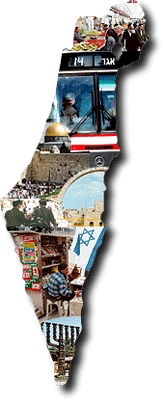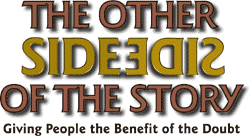Light Lines - Korach
Parshat Korach
5 Tammuz 5759 / June 19, 1999
Ohr Somayach Home Page
Around the end of the 19th century, a saintly Jew in Russia authored a work which changed the course of Judaism. The book was called Chafetz Chaim - "The Desirer of Life."
Its subject matter was the laws of proper speech. In clear language, the Chafetz Chaim led his readers through the sometimes intricate laws of slander and forbidden speech. The Chafetz Chaim's author was famous for guarding his tongue with such care that his name became synonymous with that of his creation. He became known as the Chafetz Chaim.
One might have expected the Chafetz Chaim to be extremely taciturn, noticeably guarding every syllable that left his lips. The opposite was, in fact, true.
The Chafetz Chaim's son-in-law was Rabbi Zvi Hirsch Levinson. A visitor once noted the striking difference between the two men: Rabbi Levinson was a man of few words, who seemed to almost police their exit from his mouth. By comparison, the Chafetz Chaim was verbose, his conversation flowing with ease.
In this week's portion it's difficult to understand how Korach could have hoodwinked so many Jews into suspecting Moses of "lording it up" over the congregation. Just a few chapters previously, the Torah testifies that Moses was the "humblest of all men." How could there have existed even a suspicion that Moses was pumped up with his own self-image?
When we master a certain character trait, it becomes an indivisible part of who we are. However, when we are still doing "road work" on part of our character, the signs of digging and construction are everywhere. It's clear to all that there are still "men at work."
To the untrained eye, Moses might have seen lofty and removed. He was, after all, the king of the Jewish People. And he behaved in the manner of a king. But in his heart, Moses understood, as no one before or since, exactly how small he was compared to G-d. Moses didn't need to trumpet his humility. It was already integrated into his personality as seamlessly as the tarmac of last year's road repair.
Light Insight | Love of the Land | The Other Side of the Story | Response Line Ohr Somayach Home Page |
 Selections from classical Torah sources which express the special relationship between the People of Israel and Eretz Yisrael Tsefat For Jewish settlers and visitors during the last five hundred years Tsefat has been one of the Land of Israel's "sacred cities." A visit to its ancient synagogues and cemetery takes one back to the golden days of the city when Rabbi Yitzchak Luria ("Arizal") and his disciples established it as the center of Kabbalistic learning. Here too lived and died Rabbi Yosef Caro, author of the Shulchan Aruch (the Code of Jewish Law), Rabbi Shlomo Alkebetz, author of the "Lecha Dodi" sung on Shabbat eve, Rabbi Yaakov Berrav, who made an abortive attempt to reestablish the Sanhedrin, and many other famous saints and scholars. The cool air and beautiful mountainous surroundings of Tsefat attract many people from the entire country during the summer, but the year-long population remains small. A curious blend of art, music and mysticism endows this city with a unique personality during peak season. Among the institutions functioning in Tsefat is "Shalom Rav," a yeshiva for students with limited backgrounds in Jewish education, headed by American-born Rabbi Rafael Weingot and a similar seminary for women, Sharei Bina, run by his wife. |
Light Insight | Love of the Land | The Other Side of the Story | Response Line Ohr Somayach Home Page |
My wife and I, recently married in New York, now live in Jerusalem. Occasionally, when there is something from the States that we can't get here, we ask one of our family members if they wouldn't mind sending it to us.
Not long ago, my wife ordered something from a small shop in New Jersey. She asked the saleslady to send it to my mother, and when it arrived there, she planned to ask my mother to forward it along to us in Israel.
A few days later my wife decided that she didn't want to trouble my mother, who was quite busy at the time, and instead she thought she would ask her grandmother, who might appreciate the little favor she could do for us. She called back the saleslady and told her she should send the package to her grandmother's address instead. The saleslady was happy to oblige and took the new address information over the phone.
Within the month, my wife's grandmother called us at home, panic in her voice. A package had come for us, from my mother. Why wouldn't my mother send it to us, forwarding it to my grandmother to send? What could possibly be the reason? She just couldn't understand it. She had called my father-in-law to figure it out, and he didn't understand it at all, either. My wife tried to calm her down and figure out what had happened, and eventually her grandmother agreed to send the package to us in Israel.
When it eventually arrived, my wife claimed it from the post office and brought it home. She removed the brown paper wrapping that her grandmother had sent it in, and found the solution to the mystery on the layer of brown paper underneath. Written in large blue letters, crossed out but clearly legible, was my mother's address. On top of it was a small printed address label with my grandmother's name on it. The saleslady must have made up the package according to my wife's first instructions, and then affixed the new address label to the old wrapping according to the second set of instructions. The result looked like my mother had actually received it and passed it along to my wife's grandmother to take care of. In fact it had never gone there. We managed to rectify the situation somewhat, explaining to everyone what had happened.
How much easier it is, however, not to bear bad feelings towards others in the first place, rather than having to erase a negative sentiment about someone after it has taken hold.
Light Insight | Love of the Land | The Other Side of the Story | Response Line Ohr Somayach Home Page |
Leo Bellcore wrote:
What are you supposed to do if a Torah scroll falls? Someone told me they were in the room with a Torah that was being shown to children, when one side of the Torah rolled off the table and onto the floor. What are people supposed to do - should one person fast for a day, 40 people for a day, or one person fast for 40 days? Or is this a "bubba meisa" (tall-tale)?
Dear Leo,
It's no "bubba - meisa."
A Torah Scroll is a very holy object. To drop a Torah Scroll indicates a certain lack of care and realization of its sanctity - you'd be careful showing children a sixth dynasty Ming vase.
When someone does something wrong, certain acts can lessen his accountability. Such an act is called a "tikun." A tikun usually follows a rule known as mida kneged mida - meaning that it is related conceptually to the transgression. Fasting 40 days helps atone for the disrespect shown to the Torah Scroll, which was given in 40 days. Since everyone present sensed the enormous disgrace and degradation, they too would need to fast.
Nowadays, people are not as hale and hardy as they used to be. Instead of fasting, therefore, everyone present would give charity instead.
In your case, the Torah Scroll did not fall completely to the ground - rather, only one side fell. I asked a halachic authority about this, and he said that since the Torah Scroll did not fall completely, charity should be given since the Torah Scroll was nonetheless dishonored.
Produced by the Office of Communications
Editor: Raphael Scott Leban
Production: Eliezer Shapiro
Light Insight: Yaakov Asher Sinclair
HTML Design: Michael Treblow
HTML Production: Eli Ballon
© 1999 Ohr Somayach International - All rights reserved. This publication may be distributed to another person intact without prior permission. We also encourage you to include this material in other publications, such as synagogue newsletters. However, we ask that you contact us beforehand for permission, and then send us a sample issue.
This publication is available via E-Mail
Ohr Somayach Institutions is an international network of Yeshivot and outreach centers, with branches in North America, Europe, South Africa and South America. The Central Campus in Jerusalem provides a full range of educational services for over 685 full-time students.









